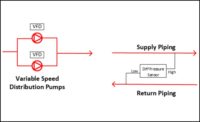Far too often, building operators are overwhelmed with the number of alarms generated on their building automation systems (BAS). This results in alarms being ignored, the critical ones not identified and addressed in a timely manner, and even decision paralysis. The alarms become a liability instead of an asset, and their intended purpose is lost. Such a scenario, where building operators are overwhelmed by alarms, is referred to as “alarm saturation” in this article.
Attitudes Toward Alarm Saturation
There seems to be three common beliefs amongst building operators who are living in alarm saturation:
- “Most of these are just nuisance alarms.”
- “This system has never operated correctly.”
- “I don’t have the time or resources to address these alarms.”
Below are my thoughts on each of those beliefs:
- I too have encountered a lot of nuisance alarms, and my next two columns will dive into the details on how we can reduce them. However, many alarms are legit, and I feel it is dangerous to dismiss all such alarms as nuisances.
- Based on my experience in troubleshooting existing buildings, I agree it is likely the case the system has never operated correctly. However, the BAS alarms are often great clues into what the system’s deficiencies are. Investigation into the alarms can be used as an avenue to correct system operation.
- I empathize with building operators when they say they don’t have the time or resources. I also realize that additional, competent help is not right around the corner for them. If they are to get ahead in what can be an overwhelming job, their best bet is to get more efficient at their job. Utilizing alarms proactively provides such an opportunity.
Reasons for Alarm Saturation
There are both technical and process-related reasons for why so many buildings live in alarm saturation.
Technical reasons include:
- Unnecessary alarms
- Inappropriate alarm threshold and delays
- Unconfigured/undefined alarm priority levels
- Inappropriate latching or lack of latching (this is the topic of May’s column)
- Lack of alarm suppression (this is the topic of June’s column)
The process-related reasons for alarm saturation primarily reside with insufficiencies in how alarming is handled during the project delivery process for new construction and major renovation projects. There is a common belief that alarming is “a minor detail,” something that someone else will figure out, and not something to waste time with during the design and construction phase of a project.
Oftentimes, the specified sequence of operation in the design does not provide adequate direction when it comes to alarming. Sometimes, such discussion on alarming is omitted altogether. When pressed for clarity on their specified alarming, often the designer’s response is something to the effect of “the temperature controls contractor is to coordinate with the owner’s staff on what they would like for alarming.” Indeed, a lot of the technical parameters regarding alarming do need to be tailored to the facilities staff who will inherit the system. The owner needs to be engaged, but if that is not to be done until project turnover, the chance of a successful alarming program being established is greatly diminished. Lack of specification on alarming in the contract documents will inevitably lead to the facilities staff just getting whatever the temperature control contractor provides them without much opportunity for input. The coordination between the facilities staff and temperature controls contractor is often just a brief, rushed explanation buried in a firehose of owner’s training.
Solutions to Alarm Saturation
Facility Standards:
For owners with larger portfolios of buildings, it is highly recommended they develop a Facility Standard which discusses the requirements for BAS alarms. This will make alarm specification during the design phase of a new construction project much smoother. It will also result in greater consistency in alarming parameters and protocols when multiple design teams and temperature controls contractors are working in various buildings across the owner's portfolio.
Such a standard should address:
- Which alarms are to be configured
- Alarm thresholds, delays, and return-to-normal values
- Alarm priority levels
- Notification protocols
- Which alarms are to be latching vs unlatching
- When certain alarms are suppressed
Development of such a standard would merely take a few hours with the appropriate personnel, but it’s payback would be enormous in the efficiencies it would bring to future building operations. It is highly recommended building owners engage their preferred commissioning providers to help facilitate this process. Commissioning providers should encourage clients to develop such a standard as well.
New Construction and Major Renovations:
For new construction and major renovation projects, more attention needs to be paid to the alarming requirements. If a Facility Standard already exists for the owner, that is a great starting place, but this does not alleviate the design engineer from incorporating only what truly applies as well as expanding on some alarming for systems unique to the project. Commissioning providers are to advocate for clarity from the designers regarding alarming and facilitate owner participation in the development of those alarming requirements. Much of this coordination should be done early in the design process, but some specifics, such as what alarms from standalone equipment with onboard controllers are to be monitored by the BAS, will need to be addressed at a controls integration meeting after equipment submittals are approved.
Additionally, alarming cannot be omitted from functional performance testing and a larger sampling rate should be placed on more sophisticated alarms, such as those with latching and suppression requirements.
Existing Buildings:
Owners of existing buildings can use the investigation of alarms as a means to improve their buildings' operations. Alarms can serve as key indicators of where attention should be placed during Sustaining Phase1 of an ongoing commissioning process.
Are those alarms really just nuisance alarms? I would recommend any facilities staff member or commissioning provider dig into learning the sequence of operation for the system in question before they make such a determination. Investigate each alarm, both active and inactive alarms, by reviewing trended data to identify the circumstances that led to the alarm condition. If the alarm truly is a nuisance alarm, get rid of it or suppress it as appropriate, and then replicate those adjustments to similar alarms elsewhere. The investigation into the alarm will often identify where something is wrong; either a programming error, inappropriate or uncoordinated set points, or a component failure. Addressing this discovery will improve system operation, and the investigator will better understand how the system operates going forward. I have found this proactive approach to the be most effective means to get building systems to operate efficiently, effectively, and consistently during an ongoing commissioning process.
Conclusion
Alarming is considered so minor in the grand scheme of things during a construction project that no one wants to deal with it. To be honest, I don’t have some peculiar passion for alarming either. However, I have witnessed firsthand too many times that this lack of attention can result in a building saturated with alarms. There is a better way! Attention needs to be brought to this shortcoming in our industry, and commissioning providers need to advocate for building operators who bear the burden of alarm saturation.
1Building Commissioning Association, Ongoing Commissioning Best Practices





